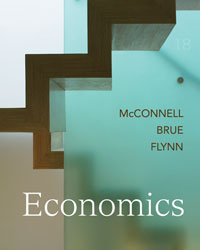 
Economics (McConnell), 18th EditionFeature Summary- Two-Path Macro: Realizing that different teachers teach macro in different ways, the authors have extensively reorganized and revised Chapters 8, 9, and 10 to provide two alternative paths through the macro. This way, instructors who focus exclusively on Aggregate Demand-Aggregate Supply Model can now more easily skip the Aggregate Expenditure (Keynesian) model than before, while those who teach both the AD/AS and AE models can continue to do so in a logical manner.
- A Patient, Step-by-Step Approach: realizing that for most students, this is their first introduction to economics, the authors take a patient, step-by step approach to teaching the material. The authors explain the theory and models slowly and thoroughly. This approach is easier to follow than that of many other texts on the market which make assumptions and jump through material quickly, leaving students behind.
- Balanced Coverage: McConnell, Brue, and Flynn’s Economics has stayed the number one selling text over the years because of the thorough and neutral coverage of the material—they present both sides and let instructors and students make up their own minds.
- Multiple-choice “Quick Quizzes” to accompany the Key Graphs: Graphs that have special relevance are labeled “Key Graphs,” and each includes a multiple-choice quiz. These 4-question quizzes allow students to test their understanding in the multiple-choice format. Answers are provided on the page, but upside down.
- Extensive Glossary: Over 30 pages with 1000 entries.
- Figure Legends: Legends accompanying diagrams are often in-depth self-contained analyses of the concepts. The legends are quick synopses of important ideas. They help the students understand the visual representations more fully.
- Study Questions: 10-12 questions follow every chapter, one of which refers to the Last Word Essay; several of the questions, designated "key questions," are cited in the body of text and answered at the book's end.
- Quick Review Boxes: 3-4 mini lists interspersed in each chapter used to review content. Students get a chance to review what they’ve read and as a result, retain more.
- Current Analysis of Monetary Policy: The authors have written the discussion of monetary policy to help the student understand the Fed’s focus on the federal funds rate, and how changes in that rate affect other interest rates and the overall economy. In Chapter 14, the authors demonstrate how the Fed targets a specific federal funds rate and then uses open-market operations to drive the rate to that level and hold it there (see Figure 14.3). This analysis will help students interpret the news as it relates to Fed announcements about federal funds rates.
- Assessment-Ready Learning Objectives and Testing: Each chapter begins with measurable learning objectives. These learning objectives are cross-referenced to specific test bank questions to allow construction of measurement instruments. This direct link between objectives and content facilitates now common accreditation efforts necessary to meet assurance of learning requirements.
 |  |
|





